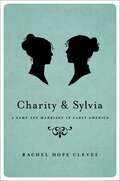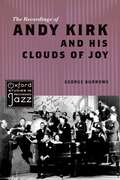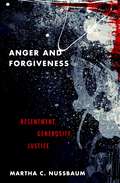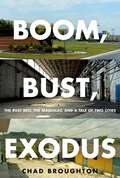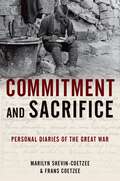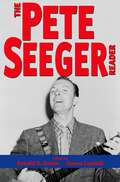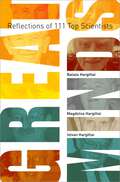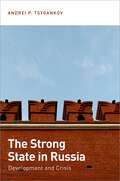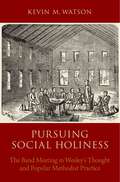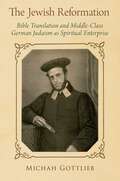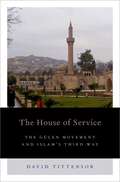- Table View
- List View
Charity and Sylvia: A Same-Sex Marriage in Early America
by Rachel Hope ClevesConventional wisdom holds that same-sex marriage is a purely modern innovation, a concept born of an overtly modern lifestyle that was unheard of in nineteenth century America. But as Rachel Hope Cleves demonstrates in this eye-opening book, same-sex marriage is hardly new. Born in 1777, Charity Bryant was raised in Massachusetts. A brilliant and strong-willed woman with a clear attraction for her own sex, Charity found herself banished from her family home at age twenty. She spent the next decade of her life traveling throughout Massachusetts, working as a teacher, making intimate female friends, and becoming the subject of gossip wherever she lived. At age twenty-nine, still defiantly single, Charity visited friends in Weybridge, Vermont. There she met a pious and studious young woman named Sylvia Drake. The two soon became so inseparable that Charity decided to rent rooms in Weybridge. In 1809, they moved into their own home together, and over the years, came to be recognized, essentially, as a married couple. Revered by their community, Charity and Sylvia operated a tailor shop employing many local women, served as guiding lights within their church, and participated in raising their many nieces and nephews. Charity and Sylvia is the intimate history of their extraordinary forty-four year union. Drawing on an array of original documents including diaries, letters, and poetry, Cleves traces their lives in sharp detail. Providing an illuminating glimpse into a relationship that turns conventional notions of same-sex marriage on their head, and reveals early America to be a place both more diverse and more accommodating than modern society might imagine, Charity and Sylvia is a significant contribution to our limited knowledge of LGBT history in early America.
Charity and Sylvia: A Same-Sex Marriage in Early America
by Rachel Hope ClevesConventional wisdom holds that same-sex marriage is a purely modern innovation, a concept born of an overtly modern lifestyle that was unheard of in nineteenth century America. But as Rachel Hope Cleves demonstrates in this eye-opening book, same-sex marriage is hardly new. Born in 1777, Charity Bryant was raised in Massachusetts. A brilliant and strong-willed woman with a clear attraction for her own sex, Charity found herself banished from her family home at age twenty. She spent the next decade of her life traveling throughout Massachusetts, working as a teacher, making intimate female friends, and becoming the subject of gossip wherever she lived. At age twenty-nine, still defiantly single, Charity visited friends in Weybridge, Vermont. There she met a pious and studious young woman named Sylvia Drake. The two soon became so inseparable that Charity decided to rent rooms in Weybridge. In 1809, they moved into their own home together, and over the years, came to be recognized, essentially, as a married couple. Revered by their community, Charity and Sylvia operated a tailor shop employing many local women, served as guiding lights within their church, and participated in raising their many nieces and nephews. Charity and Sylvia is the intimate history of their extraordinary forty-four year union. Drawing on an array of original documents including diaries, letters, and poetry, Cleves traces their lives in sharp detail. Providing an illuminating glimpse into a relationship that turns conventional notions of same-sex marriage on their head, and reveals early America to be a place both more diverse and more accommodating than modern society might imagine, Charity and Sylvia is a significant contribution to our limited knowledge of LGBT history in early America.
The Voice of the Past: Oral History (Oxford Oral History Series)
by Paul ThompsonOral history gives history back to the people in their own words. And in giving a past, it also helps them towards a future of their own making. Oral history and life stories help to create a truer picture of the past and the changing present, documenting the lives and feelings of all kinds of people, many otherwise hidden from history. It explores personal and family relationships and uncovers the secret cultures of work. It connects public and private experience, and it highlights the experiences of migrating between cultures. At the same time it can bring courage to the old, meaning to communities, and contact between generations. Sometimes it can offer a path for healing divided communities and those with traumatic memories. Without it the history and sociology of our time would be poor and narrow. In this fourth edition of his pioneering work, fully revised with Joanna Bornat, Paul Thompson challenges the accepted myths of historical scholarship. He discusses the reliability of oral evidence in comparison with other sources and considers the social context of its development. He looks at the relationship between memory, the self and identity. He traces oral history through its own past and weighs up the recent achievements of a movement which has become international, with notably strong developments in North America, Europe, Australia, Latin America, South Africa and the Far East, despite resistance from more conservative academics. This new edition combines the classic text of The Voice of the Past with many new sections, including especially the worldwide development of different forms of oral history and the parallel memory boom, as well as discussions of theory in oral history and of memory, trauma and reconciliation. It offers a deep social and historical interpretation along with succinct practical advice on designing and carrying out a project, The Voice of the Past remains an invaluable tool for anyone setting out to use oral history and life stories to construct a more authentic and balanced record of the past and the present.
VOICE OF THE PAST ORAL HISTORY ORALHIS C: Oral History (Oxford Oral History Series)
by Paul ThompsonOral history gives history back to the people in their own words. And in giving a past, it also helps them towards a future of their own making. Oral history and life stories help to create a truer picture of the past and the changing present, documenting the lives and feelings of all kinds of people, many otherwise hidden from history. It explores personal and family relationships and uncovers the secret cultures of work. It connects public and private experience, and it highlights the experiences of migrating between cultures. At the same time it can bring courage to the old, meaning to communities, and contact between generations. Sometimes it can offer a path for healing divided communities and those with traumatic memories. Without it the history and sociology of our time would be poor and narrow. In this fourth edition of his pioneering work, fully revised with Joanna Bornat, Paul Thompson challenges the accepted myths of historical scholarship. He discusses the reliability of oral evidence in comparison with other sources and considers the social context of its development. He looks at the relationship between memory, the self and identity. He traces oral history through its own past and weighs up the recent achievements of a movement which has become international, with notably strong developments in North America, Europe, Australia, Latin America, South Africa and the Far East, despite resistance from more conservative academics. This new edition combines the classic text of The Voice of the Past with many new sections, including especially the worldwide development of different forms of oral history and the parallel memory boom, as well as discussions of theory in oral history and of memory, trauma and reconciliation. It offers a deep social and historical interpretation along with succinct practical advice on designing and carrying out a project, The Voice of the Past remains an invaluable tool for anyone setting out to use oral history and life stories to construct a more authentic and balanced record of the past and the present.
Iran in World History (New Oxford World History)
by Richard FoltzHome of one of the world's most ancient and enduring civilizations, Iran has been at the nexus of world history for the past three thousand years. Situated at the crossroads between East and West, it has been marked by its encounters with other cultures and has influenced them with its own. From paradise gardens and Persian carpets to the mystical poetry of Rumi and Hafez, Iran's contributions have earned it a place among history's most refined and sophisticated societies. In this book, Richard Foltz traces the spread of Iranian culture among diverse populations ranging from the Mediterranean to the Indian Ocean, and along the Silk Roads as far as China, from prehistoric times up to the present day. He emphasizes the range of contributions Iran has made to world history by highlighting the roles of key figures such as the ancient empire-builders Cyrus the Great and Darius I, the medieval polymath Avicenna, and early modern Mughal rulers such as Shah Jahan, who built India's celebrated Taj Mahal. From the establishment of the Pahlavi dynasty by Reza Shah in 1925 until the 1979 revolution under the charismatic leadership of Ayatollah Khomeini, Iran embarked on a modernization process that led to the spread of literacy and the growth of the women's movement, making it one of the most advanced nations in the developing world. Lack of political freedoms has continued to frustrate many Iranians, however, and the country is often seen as an international pariah in the West. Iran today is rarely treated well in Western news headlines, despite remarkable achievements by individual Iranians in a wide range of fields. Encompassing religion, literature, the arts, and politics, Iran in World History offers a comprehensive history of one of the world's most influential civilizations and offers nuanced examples of its continuing role in the world today.
IRAN IN WORLD HISTORY NOWH C (New Oxford World History)
by Richard FoltzHome of one of the world's most ancient and enduring civilizations, Iran has been at the nexus of world history for the past three thousand years. Situated at the crossroads between East and West, it has been marked by its encounters with other cultures and has influenced them with its own. From paradise gardens and Persian carpets to the mystical poetry of Rumi and Hafez, Iran's contributions have earned it a place among history's most refined and sophisticated societies. In this book, Richard Foltz traces the spread of Iranian culture among diverse populations ranging from the Mediterranean to the Indian Ocean, and along the Silk Roads as far as China, from prehistoric times up to the present day. He emphasizes the range of contributions Iran has made to world history by highlighting the roles of key figures such as the ancient empire-builders Cyrus the Great and Darius I, the medieval polymath Avicenna, and early modern Mughal rulers such as Shah Jahan, who built India's celebrated Taj Mahal. From the establishment of the Pahlavi dynasty by Reza Shah in 1925 until the 1979 revolution under the charismatic leadership of Ayatollah Khomeini, Iran embarked on a modernization process that led to the spread of literacy and the growth of the women's movement, making it one of the most advanced nations in the developing world. Lack of political freedoms has continued to frustrate many Iranians, however, and the country is often seen as an international pariah in the West. Iran today is rarely treated well in Western news headlines, despite remarkable achievements by individual Iranians in a wide range of fields. Encompassing religion, literature, the arts, and politics, Iran in World History offers a comprehensive history of one of the world's most influential civilizations and offers nuanced examples of its continuing role in the world today.
Pioneers and Partisans: An Oral History of Nazi Genocide in Belorussia (Oxford Oral History Series)
by Anika WalkeThe Nazi regime and local collaborators killed 800,000 Belorussian Jews, many of them parents or relatives of young Jews who survived the war. Thousands of young girls and boys were thus orphaned and struggled for survival on their own. This book is the first systematic account of young Soviet Jews' lives under conditions of Nazi occupation and genocide. These orphans' experiences and memories are rooted in the 1930s, when Soviet policies promoted and sometimes actually created interethnic solidarity and social equality. This experience of interethnic solidarity provided a powerful framework for the ways in which young Jews survived and, several decades after the war, represented their experience of violence and displacement. Through oral histories with several survivors, video testimonies, and memoirs, Anika Walke reveals the crucial roles of age and gender in the ways young Jews survived and remembered the Nazi genocide, and shows how shared experiences of trauma facilitated community building within and beyond national groups. Pioneers and Partisans uncovers the repeated transformations of identity that Soviet Jewish children and adolescents experienced, from Soviet citizens in the prewar years, to a target of genocidal violence during the war, to a barely accepted national minority in the postwar Soviet Union.
The Recordings of Andy Kirk and his Clouds of Joy (Oxford Studies in Recorded Jazz)
by George BurrowsAndy Kirk's Clouds of Joy came from Kansas City to find nationwide fame in the later 1930s. The many records they made between 1929 and 1949 came to exemplify the Kansas City style of jazz, but they were also criticized for their populism and inauthenticity. In The Recordings of Andy Kirk' and his Clouds of Joy, George Burrows considers these records as representing negotiations over racialized styles between black jazz musicians and the racist music industry during a vital period of popularity and change for American jazz. The book explores the way that these reformative negotiations shaped and can be heard in the recorded music. By comparing the band's appropriation of musical styles to the manipulation of masks in black forms of blackface performance--both signifying and subverting racist conceptions of black authenticity--it reveals how the dynamic between black musicians, their audiences and critics impacted upon jazz as a practice and conception.
Anger and Forgiveness: Resentment, Generosity, Justice
by Martha C. NussbaumAnger is not just ubiquitous, it is also popular. Many people think it is impossible to care sufficiently for justice without anger at injustice. Many believe that it is impossible for individuals to vindicate their own self-respect or to move beyond an injury without anger. To not feel anger in those cases would be considered suspect. Is this how we should think about anger, or is anger above all a disease, deforming both the personal and the political? In this wide-ranging book, Martha C. Nussbaum, one of our leading public intellectuals, argues that anger is conceptually confused and normatively pernicious. It assumes that the suffering of the wrongdoer restores the thing that was damaged, and it betrays an all-too-lively interest in relative status and humiliation. Studying anger in intimate relationships, casual daily interactions, the workplace, the criminal justice system, and movements for social transformation, Nussbaum shows that anger's core ideas are both infantile and harmful. Is forgiveness the best way of transcending anger? Nussbaum examines different conceptions of this much-sentimentalized notion, both in the Jewish and Christian traditions and in secular morality. Some forms of forgiveness are ethically promising, she claims, but others are subtle allies of retribution: those that exact a performance of contrition and abasement as a condition of waiving angry feelings. In general, she argues, a spirit of generosity (combined, in some cases, with a reliance on impartial welfare-oriented legal institutions) is the best way to respond to injury. Applied to the personal and the political realms, Nussbaum's profoundly insightful and erudite view of anger and forgiveness puts both in a startling new light.
Anger and Forgiveness: Resentment, Generosity, Justice
by Martha C. NussbaumAnger is not just ubiquitous, it is also popular. Many people think it is impossible to care sufficiently for justice without anger at injustice. Many believe that it is impossible for individuals to vindicate their own self-respect or to move beyond an injury without anger. To not feel anger in those cases would be considered suspect. Is this how we should think about anger, or is anger above all a disease, deforming both the personal and the political? In this wide-ranging book, Martha C. Nussbaum, one of our leading public intellectuals, argues that anger is conceptually confused and normatively pernicious. It assumes that the suffering of the wrongdoer restores the thing that was damaged, and it betrays an all-too-lively interest in relative status and humiliation. Studying anger in intimate relationships, casual daily interactions, the workplace, the criminal justice system, and movements for social transformation, Nussbaum shows that anger's core ideas are both infantile and harmful. Is forgiveness the best way of transcending anger? Nussbaum examines different conceptions of this much-sentimentalized notion, both in the Jewish and Christian traditions and in secular morality. Some forms of forgiveness are ethically promising, she claims, but others are subtle allies of retribution: those that exact a performance of contrition and abasement as a condition of waiving angry feelings. In general, she argues, a spirit of generosity (combined, in some cases, with a reliance on impartial welfare-oriented legal institutions) is the best way to respond to injury. Applied to the personal and the political realms, Nussbaum's profoundly insightful and erudite view of anger and forgiveness puts both in a startling new light.
Poiesis: Manufacturing in Classical Athens
by Peter ActonPoiesis brings together archaeological finds, ancient texts and inscriptions, recent scholarly analysis, and the expertise of modern craftsmen to investigate every known facet of Athens' manufacturing activities. Despite the fact that Athenians consumed great quantities of manufactured goods, and around half of the residents of classical Athens can be shown to have been dependent for survival on manufacturing in some form, the subject has been almost completely neglected by historians. The book draws on the analytical techniques of contemporary business economics--supply and demand, competition theory, and risk-return analysis--to explain events and choices. Manufacturing operations are classified in an original framework that explains why certain segments were suited to the sole craftsman and others to teams of slaves, and deduces earnings potential based upon barriers to entry and competitive differentiation. The result is a new and refreshing angle on how Athenian society operated that complements political, military, and literary perspectives, with important and often surprising implications. Among other insights the analysis shows how fragmented industry structures were fundamental to the workings of Athenian democracy by enabling citizens to supplement their income through casual manufacturing activity.
Boom, Bust, Exodus: The Rust Belt, the Maquilas, and a Tale of Two Cities
by Chad BroughtonDonald Trump and Bernie Sanders owed much of their unexpected popularity in the 2016 primaries to their respective stances on trade and immigration policy. Political elites and policy experts were bewildered by combative talk of building a wall and the ubiquity of anti-TPP (Trans-Pacific Partnership) sloganeering in what many saw as a bizarre election cycle. They have scrambled to explain both Trump's victory and the new political fault lines that have emerged in both major political parties, largely around trade and immigration. In struggling industrial towns and cities, the rise of Trump and Sanders was less of a surprise. These places have long weathered globalization's storm. Many feel left behind and sold short. They are anxious, and they're demanding answers. Galesburg, Illinois, is one such city.
Boom, Bust, Exodus: The Rust Belt, the Maquilas, and a Tale of Two Cities
by Chad BroughtonDonald Trump and Bernie Sanders owed much of their unexpected popularity in the 2016 primaries to their respective stances on trade and immigration policy. Political elites and policy experts were bewildered by combative talk of building a wall and the ubiquity of anti-TPP (Trans-Pacific Partnership) sloganeering in what many saw as a bizarre election cycle. They have scrambled to explain both Trump's victory and the new political fault lines that have emerged in both major political parties, largely around trade and immigration. In struggling industrial towns and cities, the rise of Trump and Sanders was less of a surprise. These places have long weathered globalization's storm. Many feel left behind and sold short. They are anxious, and they're demanding answers. Galesburg, Illinois, is one such city.
Commitment and Sacrifice: Personal Diaries from the Great War
by Marilyn Shevin-Coetzee Frans CoetzeeFor years, those who attempted to understand the devastation of World War I looked to the collections of diplomatic documents, the stirring speeches, and the partisan memoirs of the leading participants. However, those accounts offered little by way of the intimate history, or the individual experiences of those involved in the Great War. In Commitment and Sacrifice, Marilyn Shevin-Coetzee and Frans Coetzee provide just such an "intimate look" by bringing together previously unpublished diaries of five participants in the First World War and restoring to publication the diary of a sixth that has long been out of print. The six diaries address the war on the Western front and the Mediterranean, as well as behind the lines on the home front. Together, these diarists form a diverse group: John French, a British sapper who dug precarious tunnels beneath the trenches of the Western Front; Henri Desagneaux, a French infantry officer embroiled in years of bloody combat; Philip T. Cate, an idealistic American volunteer ambulance driver who sought to save lives rather than take them; Willy Wolff, a German businessman caught in England upon the war's outbreak and interned there for the duration; James Douglas Hutchison, a New Zealand artilleryman fighting thousands of miles from home; and Felix Kaufmann, a German machine gunner, captured and held as a prisoner of war. Through the personal reflections of these young men, we are transported into many of the iconic episodes of the war, from the upheaval of mobilization through the great battles of Gallipoli, Verdun, and the Somme, as well as the less familiar "other ordeal" of internment and captivity. As members of the so-called Generation of 1914 (each was between nineteen and twenty-four years old), they shared an unwavering commitment to their countries' cause, and possessed a steadfast determination to persevere despite often appalling circumstances. Collectively, these diaries illuminate the sacrifices of war, whether willingly volunteered or stoically endured. That the diarists had the desire and the ingenuity to record their experiences, whether for their families, posterity, or simply their own personal satisfaction, gives readers the ability to eavesdrop on horrors long past. A century later, we are fortunate that they were both willing and able to set pencil to paper.
Commitment and Sacrifice: Personal Diaries from the Great War
by Marilyn Shevin-Coetzee Frans CoetzeeFor years, those who attempted to understand the devastation of World War I looked to the collections of diplomatic documents, the stirring speeches, and the partisan memoirs of the leading participants. However, those accounts offered little by way of the intimate history, or the individual experiences of those involved in the Great War. In Commitment and Sacrifice, Marilyn Shevin-Coetzee and Frans Coetzee provide just such an "intimate look" by bringing together previously unpublished diaries of five participants in the First World War and restoring to publication the diary of a sixth that has long been out of print. The six diaries address the war on the Western front and the Mediterranean, as well as behind the lines on the home front. Together, these diarists form a diverse group: John French, a British sapper who dug precarious tunnels beneath the trenches of the Western Front; Henri Desagneaux, a French infantry officer embroiled in years of bloody combat; Philip T. Cate, an idealistic American volunteer ambulance driver who sought to save lives rather than take them; Willy Wolff, a German businessman caught in England upon the war's outbreak and interned there for the duration; James Douglas Hutchison, a New Zealand artilleryman fighting thousands of miles from home; and Felix Kaufmann, a German machine gunner, captured and held as a prisoner of war. Through the personal reflections of these young men, we are transported into many of the iconic episodes of the war, from the upheaval of mobilization through the great battles of Gallipoli, Verdun, and the Somme, as well as the less familiar "other ordeal" of internment and captivity. As members of the so-called Generation of 1914 (each was between nineteen and twenty-four years old), they shared an unwavering commitment to their countries' cause, and possessed a steadfast determination to persevere despite often appalling circumstances. Collectively, these diaries illuminate the sacrifices of war, whether willingly volunteered or stoically endured. That the diarists had the desire and the ingenuity to record their experiences, whether for their families, posterity, or simply their own personal satisfaction, gives readers the ability to eavesdrop on horrors long past. A century later, we are fortunate that they were both willing and able to set pencil to paper.
The Pete Seeger Reader (Readers on American Musicians)
by Ronald D. Cohen and James CapaldiPerhaps the most widely recognized figure in folk music and one of the most well-known figures in American political activism, Pete Seeger now belongs among the icons of 20th-century American culture. The road to his current status as activist and respected voice of folk music was long and often rough, starting from the moment he dropped out of Harvard in the late 1930s and picked up a banjo. Editors Ronald Cohen and James Capaldi trace Seeger's long and storied career, focusing on his work as not only a singer, but also on his substantial contributions as an educator, songwriter, organizer, publisher, and journalist. The son of musicians, Seeger began his musical career before World War II and became well-known in the 1950s as a member of the commercially popular Weavers, only to be blacklisted by much of the mainstream media in the 1960s because of his progressive politics, and to return to the music scene in subsequent decades as a tireless educator and activist. The Pete Seeger Reader gathers writings from numerous sources, mixing Seeger's own work with that of the many people who have, over the years, written about him. Many of the pieces have never before been republished, and cover his entire career. A figure of amazing productivity, influence, and longevity, Seeger is author of a life that has been both cast in heroic terms and vilified. The selections in this book draw from a full range of these perspectives and will inform as they entertain, bringing into focus the life and contributions of one of the most influential figures of the twentieth century.
The World from 1000 BCE to 300 CE (New Oxford World History)
by Stanley M. BursteinThis book provides the first comprehensive history of Afro-Eurasia during the first millennium BCE and the beginning of the first millennium CE. The history of these 1300 plus years can be summed up in one word: connectivity. The growth in connectivity during this period was marked by increasing political, economic, and cultural interaction throughout the region, and the replacement of the numerous political and cultural entities by a handful of great empires at the end of the period. In the process, local cultural traditions were replaced by great traditions rooted in lingua francas and spread by formalized educational systems. This process began with the collapse of the Bronze Age empires in the east and west, widespread population movements, and almost chronic warfare throughout Afro-Eurasia, while the cavalry revolution transformed the nomads of the central Asian steppes into founders of tribal confederations assembled by charismatic leaders and covering huge territories. At the same time, new artistic and intellectual movements appeared, including the teachings of Socrates, Confucius, the Buddha, and Laozi. Increased literacy also allowed people from a wide range of social classes such as the Greek soldier Xenophon, the Indian Buddhist emperor Ashoka, the Roman emperor Marcus Aurelius, and elite women such as the poetess Sappho, the Christian martyr Perpetua, and the scholar Ban Zhao to create literary works. When the period ended in 300 CE, conditions had changed dramatically. Temperate Afro-Eurasia from the Atlantic to the Pacific was dominated by a handful of empires--Rome, Sassanid Persia, and Jin Empire-that ruled more than half the world's population, while an extensive network of trade routes bound them to Southeast and Central Asia and Sub-Saharan Africa and made possible the spread of new book based religions including Christianity, Manichaeism, Zoroastrianism, and Buddhism, thereby setting the stage for the next millennium of Afro-Eurasian history.
WORLD FROM 1000 BCE TO 300 CE C (New Oxford World History)
by Stanley M. BursteinThis book provides the first comprehensive history of Afro-Eurasia during the first millennium BCE and the beginning of the first millennium CE. The history of these 1300 plus years can be summed up in one word: connectivity. The growth in connectivity during this period was marked by increasing political, economic, and cultural interaction throughout the region, and the replacement of the numerous political and cultural entities by a handful of great empires at the end of the period. In the process, local cultural traditions were replaced by great traditions rooted in lingua francas and spread by formalized educational systems. This process began with the collapse of the Bronze Age empires in the east and west, widespread population movements, and almost chronic warfare throughout Afro-Eurasia, while the cavalry revolution transformed the nomads of the central Asian steppes into founders of tribal confederations assembled by charismatic leaders and covering huge territories. At the same time, new artistic and intellectual movements appeared, including the teachings of Socrates, Confucius, the Buddha, and Laozi. Increased literacy also allowed people from a wide range of social classes such as the Greek soldier Xenophon, the Indian Buddhist emperor Ashoka, the Roman emperor Marcus Aurelius, and elite women such as the poetess Sappho, the Christian martyr Perpetua, and the scholar Ban Zhao to create literary works. When the period ended in 300 CE, conditions had changed dramatically. Temperate Afro-Eurasia from the Atlantic to the Pacific was dominated by a handful of empires--Rome, Sassanid Persia, and Jin Empire-that ruled more than half the world's population, while an extensive network of trade routes bound them to Southeast and Central Asia and Sub-Saharan Africa and made possible the spread of new book based religions including Christianity, Manichaeism, Zoroastrianism, and Buddhism, thereby setting the stage for the next millennium of Afro-Eurasian history.
Great Minds: Reflections of 111 Top Scientists
by Balazs Hargittai Magdolna Hargittai Istvan HargittaiThroughout the 1990s and the 2000s, Istvan, Balazs, and Magdolna Hargittai conducted hundreds of interviews with leading scientists in physics, chemistry, materials, and biomedical research. These interviews appeared in a variety of publications, including Chemical Intelligencer, Mathematical Intelligencer, and Chemical Heritage. In four-thousand pages of interviews, the Hargittais had conversations with over a hundred Nobel laureates, along with many other top minds and personalities in various scientific fields. Now, in a single volume, the Hargittais have gathered the best and most notable moments of these interviews, creating a survey of the past, present, and future of science, as told by some of the most influential members of many scientific disciplines. Figures like James D. Watson, Francis Crick, and Glenn T. Seaborg share their thoughts in these pages, in a collection that includes 68 Nobel Laureates. Without exaggeration, their backgrounds come from all over the globe: scientists from the United States, the United Kingdom, Canada, France, Germany, Israel, Russia, Sweden, Switzerland, and Taiwan are featured. These interviews discuss many of the most prominent debates and issues in today's scientific climate. Great Minds is a synthesis of scientific thought, as told by some of the most notable scientists of the twentieth and twenty-first centuries.
Great Minds: Reflections of 111 Top Scientists
by Istvan Hargittai Magdolna Hargittai Balazs HargittaiThroughout the 1990s and the 2000s, Istvan, Balazs, and Magdolna Hargittai conducted hundreds of interviews with leading scientists in physics, chemistry, materials, and biomedical research. These interviews appeared in a variety of publications, including Chemical Intelligencer, Mathematical Intelligencer, and Chemical Heritage. In four-thousand pages of interviews, the Hargittais had conversations with over a hundred Nobel laureates, along with many other top minds and personalities in various scientific fields. Now, in a single volume, the Hargittais have gathered the best and most notable moments of these interviews, creating a survey of the past, present, and future of science, as told by some of the most influential members of many scientific disciplines. Figures like James D. Watson, Francis Crick, and Glenn T. Seaborg share their thoughts in these pages, in a collection that includes 68 Nobel Laureates. Without exaggeration, their backgrounds come from all over the globe: scientists from the United States, the United Kingdom, Canada, France, Germany, Israel, Russia, Sweden, Switzerland, and Taiwan are featured. These interviews discuss many of the most prominent debates and issues in today's scientific climate. Great Minds is a synthesis of scientific thought, as told by some of the most notable scientists of the twentieth and twenty-first centuries.
The Strong State in Russia: Development and Crisis
by Andrei P. TsygankovThe Russian state presents a mystery to outside observers. Although Russia was the site of some of the last century's most radical upheavals, and although Russian governments are usually characterized by autocracy, corruption, and political decay, the central government has retained a remarkable hold on the vast country. Does its historical progress represent change, or continuity? How has the political culture molded the expectations and behavior of the Russian people over time? What features of the Russian state are the keys to understanding it? The Strong State in Russia provides a succinct account of Russia's "strong state" model by reviewing the external and internal contexts in each major period and tracing its evolution over time. Every era saw the emergence and growth of a strong state as well as a subsequent decline, but in each the contexts combined in unique ways to produce very different political outcomes. Tsygankov argues that while the Western perspective on Russia is limited, there is an alternative way of thinking about the nation and its problems. Despite focusing on the contemporary Russian state, the book situates it in a broader historical continuity and explains that the roots of its development can be found in the Tsar's autocratic system. Russia's strong state has evolved and survived throughout centuries, and that alone suggests its historical vitality and possible future revival. From this perspective, the central scholarly question is not whether Russia will recreate a strong state, but, rather, what kind of a strong state it will be, and under which circumstances it will likely function.
Pursuing Social Holiness: The Band Meeting in Wesley's Thought and Popular Methodist Practice
by Kevin M. WatsonKevin M. Watson offers the first in-depth examination of an essential early Methodist tradition: the band meeting, a small group of five to seven people who focused on the confession of sin in order to grow in holiness. Watson shows how the band meeting, which figured significantly in John Wesley's theology of discipleship, united Wesley's emphasis on the importance of holiness with his conviction that Christians are most likely to make progress in the Christian life together, rather than in isolation. Demonstrating that neither John Wesley's theology nor popular Methodism can be understood independent of each other, Watson explores how Wesley synthesized important aspects of Anglican piety (an emphasis on a disciplined practice of the means of grace) and Moravian piety (an emphasis on an experience of justification by faith and the witness of the Spirit) in his own version of the band meeting. Pursuing Social Holiness is an essential contribution to understanding the critical role of the band meeting in the development of British Methodism and shifting concepts of community in eighteenth-century British society.
The Jewish Reformation: Bible Translation and Middle-Class German Judaism as Spiritual Enterprise
by Michah GottliebIn the late eighteenth century, German Jews began entering the middle class with remarkable speed. That upward mobility, it has often been said, coincided with Jews' increasing alienation from religion and Jewish nationhood. In fact, Michah Gottlieb argues, this period was one of intense engagement with Jewish texts and traditions. One expression of this was the remarkable turn to Bible translation. In the century and a half beginning with Moses Mendelssohn's pioneering translation and the final one by Martin Buber and Franz Rosenzweig, German Jews produced sixteen different translations of at least the Pentateuch. Exploring Bible translations by Mendelssohn, Leopold Zunz, and Samson Raphael Hirsch, Michah Gottlieb argues that each translator sought a "reformation" of Judaism along bourgeois lines, which involved aligning Judaism with a Protestant concept of religion. Buber and Rosenzweig famously critiqued bourgeois German Judaism as a craven attempt to establish social respectability to facilitate Jews' entry into the middle class through a vapid, domesticated Judaism. But Mendelssohn, Zunz, and Hirsch saw in bourgeois values the best means to serve God and the authentic actualization of Jewish tradition. Through their learned, creative Bible translations, these scholars presented competing visions of middle-class Judaism that affirmed Jewish nationhood while lighting the path to a purposeful, emotionally-rich spiritual life grounded in ethical responsibility.
The Jewish Reformation: Bible Translation and Middle-Class German Judaism as Spiritual Enterprise
by Michah GottliebIn the late eighteenth century, German Jews began entering the middle class with remarkable speed. That upward mobility, it has often been said, coincided with Jews' increasing alienation from religion and Jewish nationhood. In fact, Michah Gottlieb argues, this period was one of intense engagement with Jewish texts and traditions. One expression of this was the remarkable turn to Bible translation. In the century and a half beginning with Moses Mendelssohn's pioneering translation and the final one by Martin Buber and Franz Rosenzweig, German Jews produced sixteen different translations of at least the Pentateuch. Exploring Bible translations by Mendelssohn, Leopold Zunz, and Samson Raphael Hirsch, Michah Gottlieb argues that each translator sought a "reformation" of Judaism along bourgeois lines, which involved aligning Judaism with a Protestant concept of religion. Buber and Rosenzweig famously critiqued bourgeois German Judaism as a craven attempt to establish social respectability to facilitate Jews' entry into the middle class through a vapid, domesticated Judaism. But Mendelssohn, Zunz, and Hirsch saw in bourgeois values the best means to serve God and the authentic actualization of Jewish tradition. Through their learned, creative Bible translations, these scholars presented competing visions of middle-class Judaism that affirmed Jewish nationhood while lighting the path to a purposeful, emotionally-rich spiritual life grounded in ethical responsibility.
The House of Service: The Gulen Movement and Islam's Third Way (Religion and Global Politics)
by David TittensorDavid Tittensor offers a groundbreaking new perspective on the Gülen movement, a Turkish Muslim educational activist network that emerged in the 1960s and has grown into a global empire with an estimated worth of $25 billion. Named after its leader Fethullah Gülen, the movement has established more than 1,000 secular educational institutions in over 140 countries, aiming to provide holistic education that incorporates both spirituality and the secular sciences. Despite the movement's success, little is known about how its schools are run, or how Islam is operationalized. Drawing on thirteen months of ethnographic fieldwork in Turkey, Tittensor explores the movement's ideo-theology and how it is practiced in the schools. His interviews with both teachers and graduates from Africa, Indonesia, Central Asia, and Turkey show that the movement is a missionary organization, but of a singular kind: its goal is not simply widespread religious conversion, but a quest to recoup those Muslims who have apparently lost their way and to show non-Muslims that Muslims can embrace modernity and integrate into the wider community. Tittensor also examines the movement's operational side and shows how the schools represent an example of Mohammad Yunus's social business model: a business with a social cause at its heart. The House of Service is an insightful exploration of one of the world's largest transnational Muslim associations, and will be invaluable for those seeking to understand how Islam will be perceived and practiced in the future.
